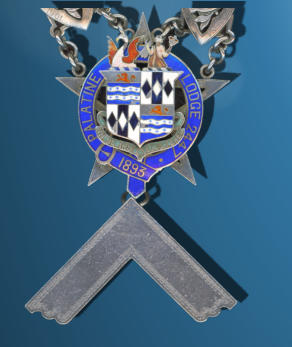


© Palatine Lodge - 1893 - 2023 - In se ipso totus teres -


W.Bro. Frederick Broadsmith
Master 1893 (F)
Bro. Hubert James Owen
Master 1894 (F)
Bro. William James Fawcus
Master 1895 (F)
W.Bro. George Samuel Smith (F)
W.Bro. William Ramsden (F)
Bro. John Joseph Tinker (F)
W.Bro. Claire Edgar Towell (F)
W.Bro. George Alfred Myers (F)
W.Bro. John Hardwicke Marsh (F)
Bro. George Graham
Master 1896 (F)
Bro. John Newton
Master 1897 (F)
Bro. John Edwin Sharples
Master 1898
Bro. William Spencer
Master 1899 (F)
Presented to
Palatine Lodge N° 2447
By Mrs Meldrum
15th Nov 1925
During which year her Husband was
Worshipful Master
The chain was designed and made by William James Dingley, he was born in 1857
in Birmingham and he died on the 21st August 1932. He established and built up the
business of a Masonic jeweller and medallist in Warstone Lane, Birmingham, making
jewels and chains for a large number of prominent Masons. He was regarded as an
authority on the subject of heraldry, of which he had an extensive knowledge. He was a
Past Master of The Faithful Lodge and a Provincial Officer of Warwickshire.
His business was founded in 1885. In May 1961 the business was merged with Toye,
Kenning & Spencer Limited. Sadly the Dingley name was dropped in July 1982. The firm
continues today, as Toye, Kenning & Spencer (Birmingham) Limited.
The silver makers mark 'W.J.D' is in an oblong format and is shown here, the letter ‘A’
dating to 1925, the Lion Passant for silver, and the Birmingham assay office mark.


The chain is finished with a heavy jewel (which is described here) and concluded
with a silver square as shown. The square is significant in that on the reverse is listed
the founder members who became Master of the Lodge and also the dedication by
Mrs Meldrum in 1925. The square is two equal flat pieces of steel fixed to form a
perfect right-angle, of 90 degrees. The square is critical in stone masonry, it allows
craftsmen to draw and delineate perfect square corners, ensuring that buildings are
perfectly square, sound and structurally strong. In Freemasonry, the square is used to
teach lessons of morality, being “square” in your actions implies honesty and fairness.
The square is shown enlarged, rotated and cropped to reveal the detail.
The Founder members listed in green all went on to be master
of the Lodge in the years shown, it’s a little bit difficult to make out
some of the engraving, those in white did not become Master and are
not included in the engraving even though they were founder
members.

















